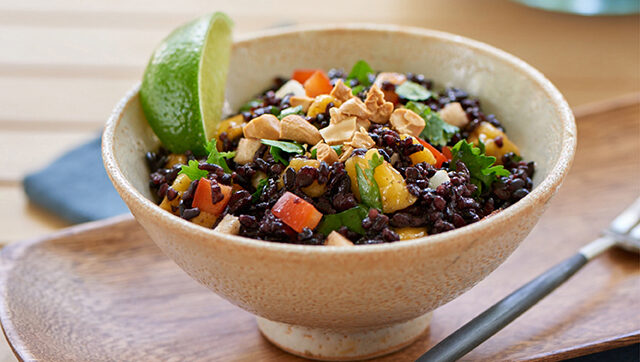Ancient Chinese tradition held that black rice was so rare that only emperors could eat it. These days, we celebrate this “forbidden rice” for its health properties: It contains more disease-fighting antioxidants — including purple and reddish pigments called anthocyanins — than any other rice variety.
Makes six servings
Prep time: 20 minutes
Cook time: 40 to 50 minutes
Salad ingredients
- ½ cup raw cashews
- 2 cups filtered water
- ½ tsp. sea salt
- 1 cup black rice
- 2 fresh mangos, diced
- 1 small jicama, peeled and diced
- 1 red bell pepper, diced
- ¼ cup chopped fresh cilantro
- ¼ cup chopped fresh mint
- 1 lime, cut into wedges
Dressing ingredients
- 3 tbs. brown-rice vinegar
- 1½ tbs. toasted sesame oil
- 1½ tbs. pure maple syrup
- 1 tbs. reduced-sodium tamari or coconut aminos
Directions
Preheat oven to 350 degrees F. Spread cashews on a sheet pan and place in the oven until toasted, approximately six to eight minutes. Remove from oven and transfer to a plate to cool.
Combine water, salt, and rice in medium saucepan. Bring to a boil, and then lower heat to low and simmer for 35 to 40 minutes, until all liquid has been absorbed. Fluff the rice with a fork, and then spread it evenly on a parchment-lined sheet pan and allow to cool.
Combine dressing ingredients together in a small bowl. Set aside.
When rice has cooled to the touch, transfer it to a large bowl and combine with mango, jicama, bell pepper, cilantro, and mint. Add dressing to taste and toss until well coated.
Garnish with toasted cashews and serve with lime wedges.
Tip: Whole foods that are deep colored — black, blue, or dark purple — are high in antioxidants and phytonutrients, which reduce inflammation.
Recipes excerpted with permission from The Essential Thyroid Cookbook by Lisa Markley and Jill Grunewald, published by Blue Wheel PressTM. Text © 2017 by Lisa Markley and Jill Grunewald. Food photography © 2016 by Kenny Johnson.
Why No Numbers? Readers sometimes ask us why we don’t publish nutrition information with our recipes. We believe that (barring specific medical advice to the contrary) if you’re eating primarily whole, healthy foods — an array of sustainably raised vegetables, fruits, nuts, seeds, legumes, meats, fish, eggs, whole-kernel grains, and healthy fats and oils — you probably don’t need to stress about the numbers. We prefer to focus on food quality and trust our bodies to tell us what we need. — The Editors
